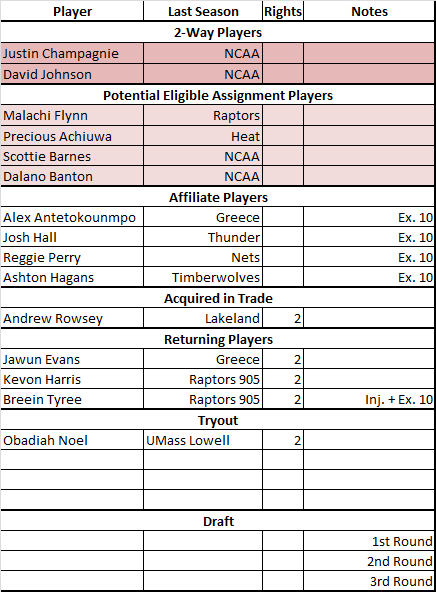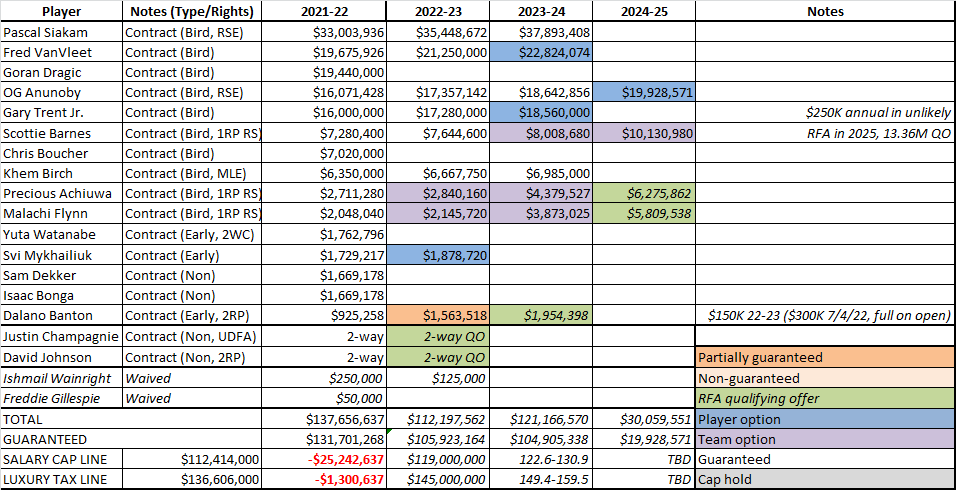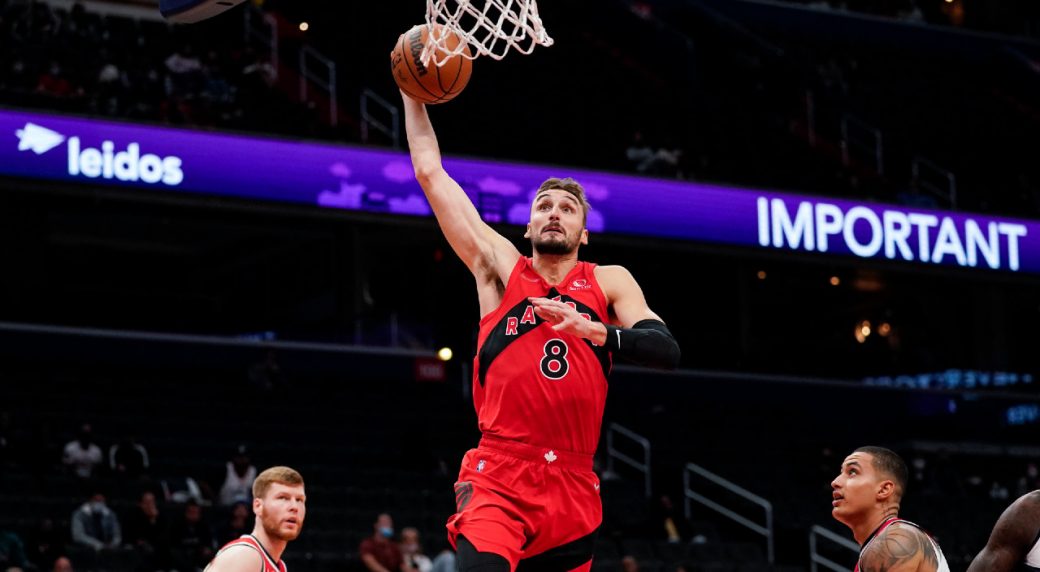The Toronto Raptors’ trip to the famous Rocky statue in Philadelphia must have resonated with Sam Dekker.
Heading into the team’s final pre-season game, Dekker looked to be on the outside of a very competitive battle for the final few roster spots. He’d barely played through four games, and with Yuta Watanabe all but assured a spot and Isaac Bonga getting heavy pre-season opportunity, it felt like it was down to Dekker against Ishmail Wainright for the last position, if the Raptors opted to keep 15 NBA contracts at all.
Pragmatically, a single pre-season performance shouldn’t carry too heavy an influence. The evaluation process for this part of the roster begins long before exhibition games. For Wainright, that went back to Las Vegas Summer League in early August. For Dekker, it was free agent mini-camps preceding that event. All of the team’s young players, new faces and roster hopefuls took part in a number of mini-camps between then and the official start of training camp in late September. What could one more game really accomplish?
In the famous words of Rocky Balboa’s cornerman Mickey Goldmill, Dekker “didn’t hear no bell.”
In the pre-season finale, Dekker caught fire, pouring in 18 points in 16 minutes, including a 4-of-5 mark on three-point attempts. He followed it up with a strong week of practice as the Raptors dragged out their decision, including an 86-of-100 mark on one of the team’s three-point shooting drills. (An aside: Svi Mykhailuk posted the highest score I’ve heard recorded this year, hitting 90-of-100 from the corners.)
The result was a very difficult decision for the Raptors, who announced Sunday that they opted to waive the quickly beloved Wainright.
Waiving Wainright means that, at least for now, Watanabe, Bonga and Dekker have secured the final three roster spots. I say “for now” because things can change quickly, but it’s worth noting that all three players will have their contracts fully guaranteed for the year if they’re not waived by Tuesday. Waiving only Wainright – and, earlier, Freddie Gillespie and Reggie Perry – suggests the Raptors are going ahead with a full roster rather than using an open spot to insulate themselves against the luxury tax.
With the final cut made, what follows is a look at the updated roster situation, cap sheet, Raptors 905 roster and more.
What’s next for the cuts?
Because Wainright had a guarantee of $250,000 (and $125,000 for next year), he is ineligible to join Raptors 905. He is eligible to join another G League program, likely through the G League draft on Oct. 23 (it’s a bit too late to be made an affiliate player somewhere).
There’s also a small chance Wainright gets claimed on waivers due to his flexible contract, which would take his money off the Raptors’ books. The likelier case is he clears waivers and teams look at him for one of the 15 open roster spots around the league.
Gillespie and Perry are both 905-eligible, though the Memphis Hustle hold Gillespie’s G League rights. The 905 could acquire those via trade, but that will depend on what Gillespie decides to do next and whether he’d like a fresh start somewhere else if he goes the G League route. Perry is expected to join the 905.
What’s up with the sign-and-waives?
If you were watching the transactions logs (or my Twitter feed) closely this week, you would have noticed the Raptors signed and immediately waiveed four other players: Breein Tyree, Josh Hall, Alex Antetokounmpo and Ashton Hagans.
These sign-and-waives are common, although spamming them like this at the end of camp is a little less common. The reason the Raptors do this is for the 905. By signing these players to Exhibit 10 contracts – non-guaranteed minimum deals that get a player a bonus to supplement their G League salary – the Raptors can assign them directly to the 905 roster as “affiliate players” rather than needing to acquire them via the draft. You can do this for up to four players each year; the Raptors technically did five here (Perry is also an affiliate player), but Tyree doesn’t count toward that total since they already held his G League rights.
Each of these players will now receive a $50,000 bonus on top of the $35,000 G League salary if they stay with the 905 long enough.
As a reminder, these player rights are superseded by NBA rights. That is, the Raptors can’t stop another NBA team from signing them out of the G League. Any of them could be poached if they’re performing well, with no restitution for the Raptors.
Raptors 905 roster situation
On Saturday, the G League will conduct its annual draft. Don’t get too excited. Last year, when the 905 snagged Gary Payton II, was an anomaly. The G League draft usually offers very little return. There are a number of interesting players who were cut late in NBA training camps and could find their way to the draft, but players will sometimes delay signing in to the G League so they have more control over their landing spot.
With three picks in total, including No. 7 overall, the 905 will be thrilled if even one draftee cracks the roster, based on historical precedent.
So, if not the draft, how does the 905 roster get filled out?
We covered the affiliate players earlier. Perry, Antetokounmpo (yes, of that family), Hall (who was with the Thunder last year) and Hagans (a Raptors Summer Leaguer who spent the tournament injured) are all directly assigned and bonus-eligible.
The 905 will also be bringing four players to camp via returning player rights. Tyree, who became a team and fan favourite quickly last year, is the most notable, though he’s expected to miss at least a few weeks of the season as he works his way back from a torn ACL. Jawun Evans and Kevon Harris will also be coming back to the team, and the 905 acquired the rights to sharpshooter and former Raptors Summer League player Andrew Rowsey.
These are all in addition to Raptors assignments. Justin Champagnie and David Johnson should both see ample 905 time as two-way players. (Champagnie has a chance to get back-end rotation minutes while the Raptors are thin. He’s been really impressive, and two-way players can be active for up to 50 NBA games this year.) Dalano Banton should also see time there unless he beats Malachi Flynn out for bench minutes. Flynn, Precious Achiuwa and Scottie Barnes are all technically eligible but unlikely to be assigned. Bonga and Dekker (and anyone, really) can also grant permission to be assigned to the 905 despite their veteran status.
The final roster spots will be filled via the draft and open tryout slots, one of which will be filled by undrafted UMass Lowell guard Obadiah Noel.

905 camp will begin Oct. 25, with the season opener taking place at Paramount Fine Foods Centre in Mississauga on Nov. 11.
The final NBA roster
Yeah, yeah, you care more about the NBA Raptors. Here’s how the opening day roster looks:
Guard: VanVleet, Dragic, Flynn, Banton, Johnson.
Wing: Trent, Barnes, Mykhailiuk, Champagnie.
Forward: Siakam, Anunoby, Watanabe, Bonga, Dekker.
Big: Birch, Achiuwa, Boucher.
It’s almost comical how uniform the roster is in terms of size. While the Raptors will be the first team since at least 2014-15 to not have a single 6-foot-10 player on their roster, they’re not “small” by average or median size. The average opening-day Raptor is 25 years old, six-foot-6.7 and 209.5 pounds with a six-foot-10.2-inch wingspan and 3.1 years of NBA experience. Twelve of their 17 players are listed above six-foot-six and 13 have a wingspan of at least six-foot-8.5.
With all of that size, length and switchability, get used to me ignoring the traditional five position definitions in favour of more role-accurate descriptors as we figure out who will be used where and how at both ends.
The salary cap and luxury tax situation
Waiving Wainright and Gillespie leaves $300,000 in dead money on the Raptors’ books, plus another $125,000 for Wainright next season. We figured coming into camp that the Raptors might be relying on an eventual Dragic trade to duck beneath the tax, and the opening day roster confirms as much.
The Raptors’ total team salary right now is $137.66 million, about $1 million above the tax. It’s actually a little higher for tax purposes, as Trent has $250,000 in “unlikely incentives” that have to be accounted for until they are either earned or not earned. (Trent’s incentive structure is a bit odd. He has six different potential bonuses of $75,000 based on the team’s performance, capped at $250,000 total. He also has to average 18 minutes and play at least 60 games to be eligible for them.) For our purposes, we’ll assume Trent is going to achieve his bonuses, just to be safe around the tax. That leaves the Raptors $1.3 million over the tax line.

Here’s where you might just ask, “Why not just pay the tax?” That’s something the Raptors have shown they’ll do in a contending season. This season doesn’t project as a contending season. There are longer-term reasons like the repeater tax or multi-year budgets to avoid it, too. Mostly, though, it’s just a lot of money – the Raptors wouldn’t just be shaving $1.3 million in salary and $1.95 million in tax payments, ducking under the tax also means you receive luxury tax payouts.
At last estimate, there were nine teams who are a combined $175 million over the tax, meaning the tax pool paid out to non-tax teams will be substantial this year. Trimming $1.3 million in salary could end up being a massive swing in the budget for future years.
Luckily for the Raptors, you have until Game 82 to get under the tax. All of the Raptors’ salaries will be guaranteed by opening night, so trades become the most logical route. We’ve seen them unload salary in the past to lessen the tax bill (attaching picks to Greg Monroe and Malachi Richardson) or get further below the tax line just in case (flipping Bruno Caboclo for Richardson).
That’s a possible route, where they could move a Dekker or Bonga type at the deadline and have their salary come entirely off the books, getting below the tax. The most obvious path, though, is dealing Dragic in a trade that takes back $18.1 million or less for the veteran point guard.
Whatever the path, it would be surprising if this is how the roster looks at the end of the season. The Raptors are simply too close to the tax line to not get below it eventually. The current snapshot does highlight how much they must like Bonga and Dekker, though, as this all would have been a lot simpler if the team opted to go with just 14 players, trimming up to $1.47 million in one fell swoop.
What’s next?
Assuming the Raptors don’t change their mind on the 14-or-15 question by Tuesday, this is it. We’re there, we made it. Real basketball on Wednesday!

